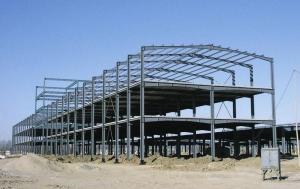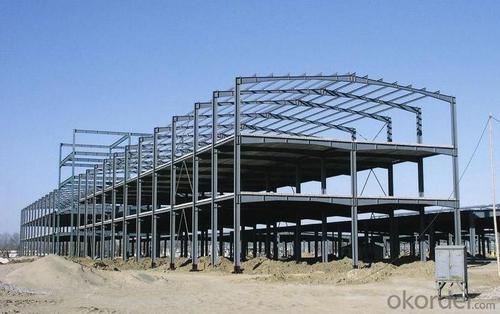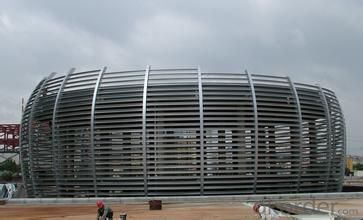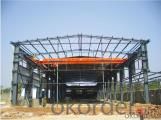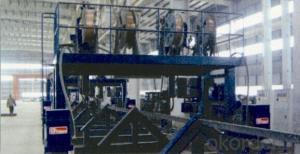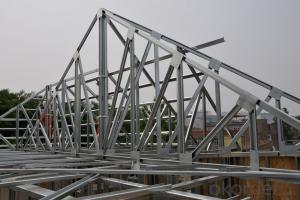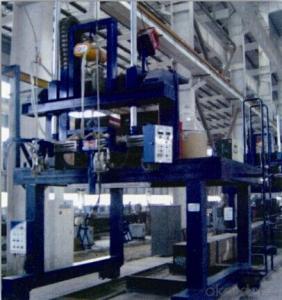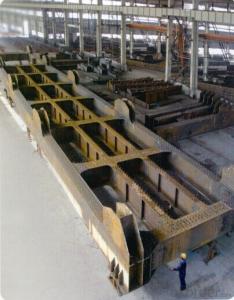Steel Structure With High Quality
- Loading Port:
- China Main Port
- Payment Terms:
- TT or LC
- Min Order Qty:
- -
- Supply Capability:
- -
OKorder Service Pledge
OKorder Financial Service
You Might Also Like
Product Description:
OKorder is offering Steel Structure with high quality at great prices with worldwide shipping. Our supplier is a world-class manufacturer of steel, with our products utilized the world over. OKorder annually supplies products to European, North American and Asian markets. We provide quotations within 24 hours of receiving an inquiry and guarantee competitive prices.
Product Applications:
Steel Structure with high quality are ideal for structural applications and are widely used in the construction of buildings and bridges, and the manufacturing, petrochemical, and transportation industries.
Product Advantages:
Steel Structure with high quality are durable, strong, and resist corrosion.
Main Product Features:
· Premium quality
· Prompt delivery & seaworthy packing (30 days after receiving deposit)
· Corrosion resistance
· Professional Service
· Competitive pricing
Product Specifications:
1. According to the project design and the component size, usually the main component parts are nude packing and shipped by bulk vessel. And the small parts are packed in box or suitable packages and shipped by containers.
2. This will be communicated and negotiated with buyer according to the design.
Engineering Design Software of light steel structure workshop
Tekla Structure \ AUTO CAD \ PKPM software etc
⊙Complex spatial structure project detailed design
⊙Construct 3D-model and structure analysis. ensure the accuracy of the workshop drawings
⊙Steel structure detail ,project management, automatic Shop Drawing, BOM table automatic generation system.
⊙Control the whole structure design process, we can obtain higher efficiency and better results
Worker | Rate of frontline workers with certificate on duty reaches 100% |
Welder | 186 welders got AWS & ASME qualification 124 welders got JIS qualification 56 welders got DNV &BV qualification |
Technical inspector | 40 inspectors with UT 2 certificate 10 inspectors with RT 2 certificate 12 inspectors with MT 2 certificate 3 inspectors with UT3 certificate |
Engineer | 21 engineers with senior title 49 engineers with medium title 70 engineers with primary title. 61 First-Class Construction Engineers 182 Second-Class Construction Engineers |
International certification | 10 engineers with International Welding engineer, 8 engineers with CWI. |
Production Flow of steel structure
Material preparation—cutting—fitting up—welding—component correction—rust removal—paint coating—packing—to storage and transportation (each process has the relevant inspection)
Usage/Applications of steel structure
*Characters of Structure Steel
1. Steel is characterized by high strength, light weight, good rigidity, strong deformation capacity, so it is suitable for construction of large-span, super high and super-heavy buildings particularly;
2. It with good homogeneous and isotropic, is an ideal elastomer which perfectly fits the application of general engineering;
3. The material has good ductility and toughness, so it can have large deformation and it can well withstand dynamic loads;
4. Steel structure’s construction period is short;
5. Steel structure has high degree of industrialization and can realize-specialized production with high level of mechanization.
*Steel structure application
1. Heavy industrial plants: relatively large span and column spacing; with a heavy duty crane or large-tonnage cranes; or plants with 2 to 3 layers cranes; as well as some high-temperature workshop should adopt steel crane beams, steel components, steel roof, steel columns, etc. up to the whole structure.
2. Large span structure: the greater the span of the structure, the more significant economic benefits will have by reducing the weight of the structure
3. Towering structures and high-rise buildings: the towering structure, including high-voltage transmission line towers, substation structure, radio and television emission towers and masts, etc. These structures are mainly exposed to the wind load. Besides of its light weight and easy installation, structure steel can bring upon with more economic returns by reducing the wind load through its high-strength and smaller member section.
4. Structure under dynamic loads: As steel with good dynamic performance and toughness, so it can be used directly to crane beam bearing a greater or larger span bridge crane
5. Removable and mobile structures: Structure Steel can also apply to movable Exhibition hall and prefabricated house etc by virtue of its light weight, bolt connection, easy installation and uninstallation. In case of construction machinery, it is a must to use structure steel so as to reduce the structural weight.
6. Containers and pipes: the high-pressure pipe and pipeline, gas tank and boiler are all made of steel for the sake of its high strength and leakproofness
7. Light steel structure: light steel structures and portal frame structure combined with single angle or thin-walled structural steel with the advantages of light weight, build fast and steel saving etc., in recent years has been widely used.
8. Other buildings: Transport Corridor, trestle and various pipeline support frame, as well as blast furnaces and boilers frameworks are usually made of steel structure.
All in all, according to the reality, structure steel is widely used for high, large, heavy and light construction.
STLA is a leading manufactuer of steel structure.The annual steel structure production capacity is 400 thousand tons. We are obtained China steel structure manufacture enterprise super-grade qualification; Industrial and civil building engineering general contracting qualifications of Class One ; Steel structure engineering general contracting qualifications of Class One ;Construction project integrated design qualification of Class One and Overseas project contracting business qualification.
FAQ:
Q1: Why buy Materials & Equipment from OKorder.com?
A1: All products offered byOKorder.com are carefully selected from China's most reliable manufacturing enterprises. Through its ISO certifications, OKorder.com adheres to the highest standards and a commitment to supply chain safety and customer satisfaction.
Q2: How do we guarantee the quality of our products?
A2: We have established an advanced quality management system which conducts strict quality tests at every step, from raw materials to the final product. At the same time, we provide extensive follow-up service assurances as required.
Q3: Can stainless steel rust?
A3: Stainless does not "rust" as you think of regular steel rusting with a red oxide on the surface that flakes off. If you see red rust it is probably due to some iron particles that have contaminated the surface of the stainless steel and it is these iron particles that are rusting. Look at the source of the rusting and see if you can remove it from the surface.
Images:

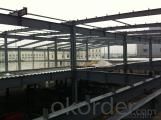
- Q: What are the considerations for designing steel structures in corrosive environments?
- When designing steel structures in corrosive environments, it is important to take several key factors into consideration. These factors include selecting appropriate materials, using protective coatings, and implementing proper maintenance and inspection procedures. To begin with, the choice of materials plays a crucial role in the design of steel structures in corrosive environments. Stainless steel or corrosion-resistant alloys are often preferred due to their high resistance to corrosion. These materials have a higher chromium content, which creates a protective layer on the steel's surface, preventing corrosion. To determine the most suitable material for the project, it is essential to carefully evaluate the specific corrosive environment, including factors such as temperature, humidity, and the presence of chemicals. Additionally, the application of protective coatings is vital in preventing corrosion. Coatings such as paints, epoxy, or zinc-rich primers can be used to provide an extra layer of protection on the steel surface. These coatings act as a barrier, preventing corrosive agents from directly contacting the steel. When selecting the appropriate coating system, factors such as durability, adhesion to the steel surface, and compatibility with the corrosive environment should be taken into account. Furthermore, proper maintenance and inspection procedures are crucial to ensure the longevity of steel structures in corrosive environments. Regular inspections should be carried out to identify any signs of corrosion or damage. If any issues are detected, prompt repairs or remedial actions should be undertaken to prevent further deterioration. Additionally, routine cleaning and maintenance procedures should be implemented to remove any contaminants that could accelerate corrosion. In conclusion, designing steel structures in corrosive environments necessitates careful consideration of materials, protective coatings, and maintenance procedures. By selecting corrosion-resistant materials, applying suitable protective coatings, and implementing effective maintenance practices, the durability and longevity of steel structures can be significantly enhanced in corrosive environments.
- Q: How are steel structures installed on-site?
- Steel structures are typically installed on-site using a combination of cranes, heavy machinery, and skilled labor. The process involves carefully positioning and aligning the steel components, securing them with bolts or welding, and ensuring structural integrity through rigorous quality checks.
- Q: How do steel structures provide resistance against blast-induced progressive collapse?
- Steel structures provide resistance against blast-induced progressive collapse due to their inherent strength and ductility. Steel is a highly durable material that can withstand high levels of impact and deformation without failing. In case of a blast, the steel members of a structure can absorb and dissipate the energy generated by the explosion, preventing the propagation of collapse. Additionally, steel structures can be designed with redundancy and alternate load paths, ensuring that even if one component fails, the load can be transferred to other parts of the structure, preventing a progressive collapse.
- Q: What are the design considerations for steel warehouses?
- Some important design considerations for steel warehouses include the structural integrity of the building, efficient space utilization, proper ventilation and lighting, fire safety measures, accessibility for loading and unloading operations, and the flexibility to accommodate future expansions or modifications. Additionally, factors such as the type of products being stored, environmental conditions, and local building codes also need to be taken into account during the design process.
- Q: What are the advantages of using lightweight steel structures?
- One advantage of using lightweight steel structures is their durability and strength. Despite their lightweight nature, these structures are capable of withstanding heavy loads and adverse weather conditions. Additionally, they have a longer lifespan compared to traditional building materials like wood or concrete. Another advantage is their versatility and ease of construction. Lightweight steel structures can be easily customized and modified, making them suitable for a wide range of applications such as residential, commercial, and industrial buildings. Moreover, these structures are typically prefabricated, allowing for faster and more efficient construction processes. Finally, lightweight steel structures are environmentally friendly as they are often made from recycled materials and can be easily recycled at the end of their life cycle.
- Q: How are steel structures designed for efficient use of water resources?
- There are several ways in which water resources can be efficiently used through the design of steel structures. Firstly, steel is a durable material that can withstand harsh weather conditions and has a long lifespan. This means that steel structures require less maintenance and repair, reducing the need for water-intensive activities like cleaning and painting. Furthermore, rainwater harvesting systems can be incorporated into steel structures. These systems collect and store rainwater for various purposes such as irrigation, flushing toilets, and industrial processes. By utilizing rainwater, steel structures can reduce their dependence on freshwater sources, ultimately conserving water resources. Moreover, efficient plumbing systems can be integrated into the design of steel structures to minimize water wastage. Low-flow fixtures like faucets and toilets can be installed to reduce water consumption without sacrificing functionality. Leak detection systems and water-efficient irrigation systems can also be included to prevent water leaks and optimize irrigation practices. Additionally, green roofs or rooftop gardens can be incorporated into the design of steel structures. These green features help reduce the heat island effect and improve stormwater management. By retaining rainwater and allowing for natural filtration, runoff is reduced and strain on municipal water systems is decreased. This promotes sustainable water management. In conclusion, steel structures can be designed to efficiently use water resources through strategies like rainwater harvesting, efficient plumbing systems, green roofs, and water-efficient irrigation systems. By incorporating these design elements, steel structures contribute to water conservation efforts and promote sustainable water management practices.
- Q: What are the different types of steel wall systems used in building structures?
- Building structures utilize various steel wall systems, each distinguished by its construction method, design, and intended application. Some prevalent types comprise: 1. Steel stud walls: Among the most frequently employed steel wall systems, steel stud walls consist of vertical steel studs and horizontal steel tracks. These lightweight, easily installable systems offer excellent structural support. 2. Curtain walls: Typically composed of steel frames and glass panels, curtain walls are non-load-bearing walls. They primarily enhance aesthetics and permit natural light entry, commonly found in commercial buildings and high-rise structures. 3. Pre-engineered metal building systems: These off-site fabricated building packages incorporate pre-cut and pre-drilled steel frames, wall panels, and roof panels. Ideal for industrial, commercial, and agricultural structures, these systems offer convenience and ease of assembly. 4. Insulated metal panels: Composite panels, known as insulated metal panels (IMPs), feature a rigid foam insulation core sandwiched between two steel skins. These panels excel in thermal and sound insulation, making them suitable for energy-efficient applications like cold storage facilities and temperature-controlled environments. 5. Steel-reinforced concrete walls: This wall system combines steel and concrete, embedding steel bars or mesh within the concrete. It imparts additional strength and stability, commonly used in high-rise buildings, bridges, and other load-bearing structures. These examples represent only a fraction of the diverse steel wall systems utilized in building structures. Selection depends on factors such as the building's purpose, design requirements, structural needs, and budgetary considerations.
- Q: What is the purpose of steel plates and gussets in structures?
- The purpose of steel plates and gussets in structures is to provide additional strength, support, and stability to the overall structure. These components are used to connect and reinforce different parts of the structure, ensuring that it can withstand various loads and forces, such as the weight of the building or wind pressure. Steel plates and gussets help distribute the load and stress evenly, increasing the structural integrity and preventing potential failures or collapses.
- Q: What are the design considerations for steel carports and parking shelters?
- Designing steel carports and parking shelters requires careful consideration of several important factors. First and foremost, the structural integrity and durability of the structure must be taken into account. Steel is an ideal material choice due to its strength and resistance to various weather conditions. To ensure the structure can withstand heavy winds, snow loads, and other potential loads, appropriate support beams and columns must be incorporated into the design. Additionally, the size and layout of the carport or shelter are crucial considerations. It is essential to plan the dimensions carefully to accommodate different vehicle sizes, including larger trucks and SUVs. The layout should also prioritize easy access and maneuverability, allowing for convenient parking and entry/exit points. Aesthetics should not be overlooked when designing carports and parking shelters. While functionality is a priority, these structures are often visible and can contribute to the overall appearance of a property. Therefore, the design should harmonize with the surrounding architecture and landscape, utilizing materials and finishes that complement existing structures. Ventilation is another important aspect to consider. Adequate airflow is necessary to prevent the buildup of heat and humidity, which can damage vehicles or create uncomfortable conditions for users. Including vents or other ventilation solutions in the design can help maintain a comfortable environment. Proper lighting is crucial for visibility and safety, especially during low-light conditions. Thoughtful placement of lighting fixtures, such as overhead or wall-mounted lights, can provide sufficient illumination while minimizing glare and light pollution. Lastly, the design should take into account any additional features or accessories desired for the carport or parking shelter. This may include storage compartments, charging stations for electric vehicles, or even a covered walkway connecting the shelter to a nearby building. Considering these additional features during the design phase can enhance the functionality and versatility of the structure. In summary, designing steel carports and parking shelters requires prioritizing structural integrity, functionality, aesthetics, ventilation, lighting, and any desired additional features. By carefully addressing these considerations, a well-designed and practical carport or parking shelter can be achieved.
- Q: Can steel structures be prefabricated off-site?
- Yes, steel structures can be prefabricated off-site. Prefabrication involves the manufacturing and assembly of building components in a controlled environment away from the construction site. This method offers several advantages, such as improved quality control, reduced construction time, and increased efficiency. Steel, being a versatile and durable material, is often chosen for prefabricated structures due to its strength and ease of fabrication.
Send your message to us
Steel Structure With High Quality
- Loading Port:
- China Main Port
- Payment Terms:
- TT or LC
- Min Order Qty:
- -
- Supply Capability:
- -
OKorder Service Pledge
OKorder Financial Service
Similar products
Hot products
Hot Searches
Related keywords
